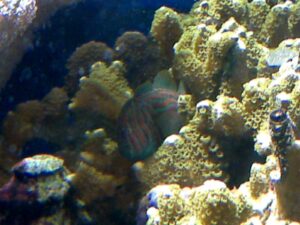Case study: Coral Gobies
Coral gobies are small fish that typically live as single breeding-pairs in isolated coral habitats. Gobies are highly adapted to living in coral habitats, and usually each patch of coral is home to just one pair. Movement between coral patches is very dangerous for a goby, so they often live most of their life in a single patch. This can make finding mates very difficult. Gobies must make the dangerous journey between coral patches in search of mates, which are often already inhabited by a paired group. Many coral gobies are bi-directional hermaphrodites. This means they can change sex in either direction, and sometimes more than once. This allows any two unpaired fish to form a mating pair. This is advantageous because it reduces the amount of time spent moving between coral patches to find mates, which is a very dangerous activity for the little coral goby. This is a situation not described well by the size advantage model (SAM), as the fish can change sex in either direction and are often of similar size. A separate theory, the risk-of-movement model, predicts hermaphroditism may occur in species where moving between habitats in the search of mates carries a high degree of risk.

CLICK HERE to continue reading: Experiments
Or navigate using the menu at the top this page